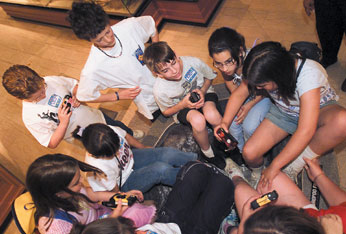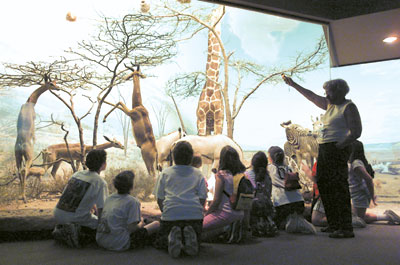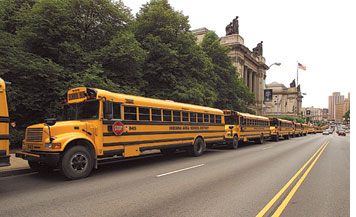My
Museums in Pittsburgh
By Lorrie Flom
 How many humans can
fit inside a single Sauropod footprint?
Just ask the third and fourth graders from St. Bernard
School
in
Indiana, Pennsylvania, who visited Carnegie Museum
of Natural History in May. During their half-day
visit, they discovered that 10 of them could fit—just
barely—into the huge model of a dinosaur footprint
in Dinosaur Hall. They also did a lot of hands-on
exploring at the museum’s Discovery Room, visited
the African and Polar World exhibits, and saw a movie
about natural
disasters in Earth Theater. How many humans can
fit inside a single Sauropod footprint?
Just ask the third and fourth graders from St. Bernard
School
in
Indiana, Pennsylvania, who visited Carnegie Museum
of Natural History in May. During their half-day
visit, they discovered that 10 of them could fit—just
barely—into the huge model of a dinosaur footprint
in Dinosaur Hall. They also did a lot of hands-on
exploring at the museum’s Discovery Room, visited
the African and Polar World exhibits, and saw a movie
about natural
disasters in Earth Theater.
In the Discovery Room,
time passed quickly as the
students moved among the many stations, viewing
birds and mammals
in a tree through binoculars, looking at layers
of time at the reconstruction of an archeological site
in western Pennsylvania, studying such residents
of the saltwater aquarium as a chocolate chip sea
star,
and examining artifacts from Africa. Student Chelsea
Miller says, “It was cool to see the frogs.
My friend Alex and I made up a story about the
animals we saw in the Discovery Room.”
Each
student had his or her favorite attraction of
the day. “I liked the Earth Theater movie best,” Alexis
Tomacruz says. “It was really cool because
it felt like you were moving!”
The 34 students
from St. Bernard School are hardly alone in
their enthusiasm for the riches of Carnegie
Museums. In fact, more than 1.6 million people
are reached by the museums each year. But at
least one-third
of them, like the kids from St. Bernard’s,
live outside the five-county region of Southwestern
Pennsylvania
(Allegheny, Beaver, Butler, Washington, and Westmoreland).
That means more than half a million people a
year either make a long trek to Pittsburgh to
visit Carnegie
Museums;
are visited in their schools by Carnegie Museums
educational outreach staff; or are touched by
the museums at
a number of off-site events.
Putting this very
large number into perspective is as simple
as returning to Indiana County
with the
third- and fourth-graders from St. Bernard
School. They share
something in common with thousands of other
Indiana County residents who view the four
Carnegie Museums
as “their” museums.

Third- and fourth-graders
from St. Bernard’s
School in Indiana, Pa.,
come to Carnegie Museum of Natural History every year
to experience
all the museum has to offer. Long-Distance Culture
Last year, nearly 9,000
residents of Indiana County traveled to one
of the four Carnegie
Museums or
were visited by one of the museums’ outreach
programs. This includes individual visitors,
group visitors
such as school groups, and the people who experience
Carnegie
Museums through the work of educational outreach
staff who conduct thousands of assembly and
in-classroom programs a year and also attend
community events
such
as county fairs.
Reaching out to other communities
is an integral part of Carnegie Museums of
Pittsburgh’s vision. As
a regional asset, the museums serve children
and adults from throughout the tri-state area—and
beyond. And more than 400 businesses enjoy
being a part of
Carnegie Museums as well by becoming Corporate
Members, organizations—large and small—that
support the museums through a contribution
and, in return,
get a variety of benefits for their employees,
ranging from free museum passes and two-for-one
admissions
to expedited entry to some of the busier venues.
Indiana County currently has four corporate
members whose owners
believe that what the four Carnegie Museums
offer is pretty valuable to their employees.
While
Indiana County
may boast a beautiful natural setting and abundant
wildlife, it takes a trip to Pittsburgh, according
to several corp-orate members, to enjoy some
of the nation’s best art, science, and
natural history offerings.
One of those Corporate
Members —
Shop ’n Save store in Saltsburg, Pa.— also
helps kids from Indiana County raise money
for special assembly programs brought to their
schools by Carnegie Museums.
The Traveling
Museums
Ellsworth Brown, Carnegie Museums of Pittsburgh
president, says, “It’s not enough
that we bring people into our doors. It’s
just as important that we take what we have
to offer outside our museums and
into the communities that we’re here
to serve.”
And travel they do. In 2002,
the education staffs of Carnegie Science Center
and Carnegie
Museum
of Natural
History traveled thousands of miles to help
teach more than 400,000 students, 4,000 of
them from
Indiana County.
They reach at least that many kids every year
through assembly and in-classroom programs
on subjects
ranging from gravity to bugs and insects—all
presented in extremely
kid-friendly ways.
On a cold day in February
2003, students in grades 1–5 at Elders
Ridge Elementary School in Saltsburg, Pa. (Indiana
County), were treated to “Space
Encounters,” one of the newest assembly programs
in Carnegie Science Center’s arsenal of fun,
interactive and, at times, explosive school programs.
Many of the programs are funded through the Shop ‘n
Save “Seeds” program, which helps schools
pay for programs conducted by the Science Center and
Carnegie Museum of Natural History. Through the Seeds
program, local Shop ’n Save stores, such as the
Shop ’n Save in Saltsburg, cover
the cost of school assemblies when $250 in receipts
are collected
for each student.
Science Center educators such as
Sarah McCloskey have been showcasing the popular
Space Encounters program
since January. She easily gets the at-tention of
her audience by first explain-ing that her job is to
make
them recognize “both the beauty and the dangers
of space travel.” First the danger: Sarah uses
a vacuum pump to show the students just how deadly
space would be without the protection of a pres-surized
suit. Lungs (a balloon) would over-inflate. Blood
(red-dyed water) would boil. And “yes,” she
answers, “
a person’s head could even burst.”
But
there’s beauty, too, she notes. During Space
Encounters, students also learn about comets, stars,
meteors, and planets. In fact, for a short time
they are the planets, as several students position
themselves
like the solar system. The “sun” can’t
get far enough away and still be on the school
grounds! Soon,
an explosion sounds, accompanied by a brilliant
flash of light. Screams of delight follow as kids
jump to their feet. It’s all part of
a demonstration about the inhospitable conditions
found in space—one that leaves a lasting
memory with the children.
Patty Shupe, a parent
of three students at Elders Ridge as well as
the vice president of the school PTA, coordinated
the visit from Carnegie Science Center. “The
kids really enjoy these programs,” she
says. “And
this visit was a good opportunity for them to
ask questions regarding the crash of the space
shuttle,” which
had occurred just prior to the presentation.
Carnegie
Science Center takes assembly programs like
Space Encounters and Great Balls of Fire to schools
throughout western Pennsylvania and as far
away as Ohio, West Virginia, and New York. Recently,
Science
Center staff were invited to give presentations
to two schools in Virginia that had discovered
the Carnegie
Science Center’s education programs on
the Internet.
Carnegie Museum of Natural History’s
assembly programs are also popular in-school
attractions. Last
year, the museum took its “Science on
Stage” performances
to 17 counties in Pennsylvania, four in West
Virginia, and one in Ohio. In Indiana County
last year, about
2,000 students enjoyed such shows as It’s
a Bird, It’s a Plane, It’s a Bug.  Last year, Carnegie Museums hosted more than
58 school groups from Indiana County alone. Last year, Carnegie Museums hosted more than
58 school groups from Indiana County alone.
Calling
All Groups
While school groups account for the largest
number of long-distance visitors to Carnegie
Museums,
other groups are lured to Pittsburgh for the
fun, the culture,
and the general good feeling they get when
visiting one of the four Carnegie Museums. Among
the Indiana County groups that visited Carnegie
Museums last year were the 4H Travel
Club; the
Brownies, Cub Scouts, and Girl Scouts troops;
Camp IQ; Saltsburg
Presbyterian Church; and Stiffler’s Greenhouse.
That’s all in addition to a total of
58 school groups.
The museums also host “Overnighters” for
any group up for a lot of adventure and a little
sleep. These special all-night visits run from
7 p.m. to 7
a.m. and take place at both Carnegie Science
Center and the Museum of Natural History. Youth
groups and
families get to enjoy all the exhibits and
shows, sleep in their sleeping bags among the
displays, and eat
breakfast the next morning. Last year, 150
guests from Indiana, Pa., participated in overnighters
at Carnegie
Science Center.
“
It’s a pretty memorable experience,” says
((name for quote to come)) from Carnegie Science Center. “They
have a lot to talk about on the long bus ride home!”
Back to Contents |